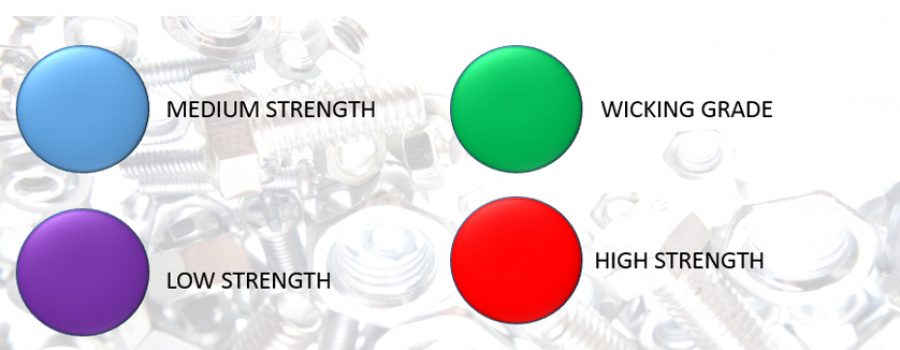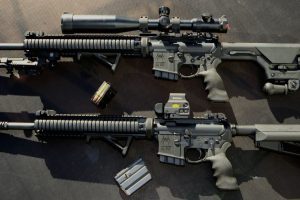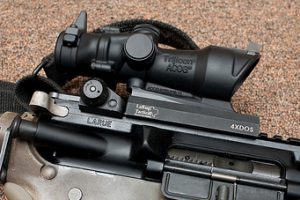Threadlockers have their places in the AR platform. But the use of the correct type of threadlocker as well as the application process is crucial to it being effective. The primary purpose of threadlockers is to dissuade unwanted movement otherwise primarily induced by vibration. That is their job.
Because of name association, threadlockers are usually called “Loctite” and this is incorrect. Loctite is a brand name for a product line, and not a generalized term.
There are three common threadlockers that can be found in use in the AR platform and these are; Loctite, Vibra-tite VC3, and Rocksett. You will also at times find the Permatex brand of threadlockers substituted for Loctite due to the common availability of the Permatex at automotive parts stores. Permatex is sometimes used in place of Loctite 620 sleeve retainer for sealing gas keys to the bolt carrier.
With most threadlockers there are different formulations available and each might have a unique name from each manufacturer, but they are usually referenced by their color. Such as the case with Loctite.
Within the commonly used Loctite brand, color can be somewhat of a universal means to denote threadlocker “strength.” Each “strength” of threadlocker will be color-coded which can aid in identification. This can be true of some other brands as well, but should not be taken as an absolute.
What Threadlocker Colors Mean

Let’s take a look at each of these colors and what they indicate:
- Purple: a slightly lower-strength threadlocker than blue that’s formulated for smaller-diameter fasteners, like set screws. It gives up its hold a little easier than blue, which is a bonus if it’s holding small screws (which have small driver fittings). Purple Loctite can be used on metals such as aluminum and brass and offers a lot of flexibility to the user. It is not common to find purple Loctite in use on the AR platform.
- Blue: a medium-duty threadlocker that’s probably the most common. Blue means the fastener can be removed with the same hand tool that installed it. It might take a little more effort, but it won’t be stuck. Blue Loctite can be found in liquid or in the form of a dry stick. Blue Loctite is commonly used by individuals when working on the AR platform.
- Red: Heavy-duty. Don’t want something to move? Then red Loctite could be your answer. Due to the amount of localized heat that is required (approx. 550 degrees) to break loose a fastener that has red Loctite applied to it, it has very little use in the AR platform. There are different “levels” of red from different manufacturers, but all are considered “permanent” in their applications; there are small differences in formulations based on fastener area size.
- Green: This color of Loctite is deceiving because it can be classified in two categories. The first one is considered to be “medium-to-high strength,” while blue is medium strength, green threadlockers are ideal for preassembled fasteners like set screws. This category is not to be confused with the next category of green Loctite which is a sleeve retainer. AKA Loctite 620. This is a high strength, high temperature resistant retaining compound for the bonding of cylindrical fitting parts. Loctite 620 has a few uses within the AR platform.
There’s not a big difference in the effective holding power of purple and blue, just, again, that purple works best on small (smaller than 0.25-in. diameter) threaded pieces and blue works best on larger threaded areas.
Applied over a large area (like threads on a collar), blue or purple may well require some heat to turn loose, but a heat gun is usually adequate. In lieu of a heat gun, a soldering iron can be used on smaller fasteners with success most of the time. Use the soldering iron to apply localized heat in the middle of the screw head.
What About Rocksett and Vibra-Tite?

Rocksett is an all-purpose adhesive ceramic cement. It only comes in one grade, and with Rocksett that is all that you need. Rocksett has a temperature resistance of -350 degrees F. to 2,015 degrees F. Rocksett can only be removed by submersing the object in a water soak. Rocksett is commonly used in place of Red Loctite in the AR platform.

Vibra-Tite is an interesting and versatile threadlocker. Unlike traditional threadlockers Vibra-Tite does not cure to form a hard bond. It is a liquid proprietary blend of thermoplastic elastomer resins that when cured to a semi solid layer remains flexible to absorb vibrations, while maintaining the “strength” between a blue and red Loctite. This allows for the vibrational energy to be transferred between the threads of a mated fastener.
Four Things to Know About Threadlockers
In general there are a few things to know about threadlockers, and this applies to virtually all of them regardless of the manufacturer or strength.
- It is absolutely necessary to get the threads properly cleaned and degreased. Use a residue-free degreaser, like non-chlorinated Brake Kleen or denatured alcohol.
- Do not shortchange or disbelieve the manufacturer instructions. Most threadlockers take a FULL 24-hours to cure! That’s not “all afternoon,” or even “overnight.” Vibra-tite and Rocksett are exceptions, but even they have required cure times.
- Threadlockers won’t set or cure in the presence of air. You can drip a few drops on the bench and it will stay liquid until some great time passes and some evaporation occurs. Threadlockers work best where there is only a tiny gap between parts. This also makes excess threadlocker pretty easy to clean up and off unwanted areas.
- Threadlockers do have an expiration date. On each bottle of threadlocker you will find a manufacturer’s expiration date. This is not a suggestion, but a fact. All of the threadlockers will lose their effectiveness over time. With Rocksett you will see that it changes color also. When you are approaching the expiration date replace the threadlocker with a new one.
So what’s the take-away here? Follow the manufacturer’s directions. Always degrease all surfaces in contact with the threadlocker. And! Let it sit a full 24 hours or it will not cure.
Applications for Threadlockers
So, where to use which, and when? Everybody has their input on the use of threadlocker. To use it. To not use it. This type for this. This type for that. However, there are a few specific points and processes in a build where I highly recommend the use of threadlocker.
The first that comes to mind is installing the gas block to the barrel with set screws. If this is the method that you choose to secure it, then I highly recommend dimpling the barrel and using red Loctite 271 on each set screw. Some individuals choose to use Rocksett on the gas block set screws. When pinning a gas block to the barrel I use Loctite 620 (green sleeve retaining compound) or equivalent on the taper pins.
Another application for red Loctite 271 is for muzzle brake installation. If you chose this route, just put the threadlocker right back against the muzzle shoulder. That’s all that’s needed. Some competition shooters will also use red Loctite to secure their muzzle devices as this reduces the chance of over torqueing the muzzle device and causing a muzzle constriction. This is also a concern with larger calibers that have a thin barrel wall. The red Loctite is typically used in conjunction with a minimum amount of torque. Rocksett is also commonly used on muzzle devices. Especially QD attachments for suppressors.
Some individuals will use Loctite 620 or equivalent to bed the barrel extension into the upper receiver. This is done in lieu of using stainless steel shim stock. Through various accuracy tests I have found that bedding a barrel has improved accuracy in the guns that I’ve done it to. I have used both methods but currently prefer the shim stock method. Some barrel manufacturers such as Criterion recommend the liquid bedding.
Dependent upon the class of threads and fit of the receiver extension to the lower receiver, I will apply Vibra-Tite VC3 to the receiver extension threads prior to installation. This is at times done even though I stake the castle nut. This is especially true if a client’s gun has an end plate made out of titanium or some other metal that cannot be easily staked. If the receiver extension is a rifle extension, it always receives Vibra-Tite VC3.
Handguard screws and retainers will either receive blue Loctite or Vibra-Tite VC3. This is kinda dependent upon the designs. Sometimes Vibra-Tite will peel out a little bit from the threads and be visible upon tightening. Or if the end of the screw is visible once installed (like a pinch lock style handguard) you may be able to see traces of orange from the Vibra-Tite. In cases like this I may blue Loctite instead. Accessories that get attached to the rail via M-Lok, KeyMod, whatever mounting system, also get Vibra-Tite VC3.
When installing new BCG gas keys I always use Loctite 620 or the Permatex equivalent to seal the gas key to the carrier.
When it comes to small screws on the lower receiver they will either receive purple or blue Loctite, or Vibra-Tite VC3. The Magpul BAD Lever and how it attaches to the bolt catch, trigger adjustment screws, tension set screws for cassette triggers. Etc. will either get blue Loctite or Vibra-Tite VC3. If I have a client gun that comes in with anti-walk pins then they will receive purple Loctite.
Optic rings, red dot mounts, picatinny rail attachments and the like will get Vibra-Tite VC3.
Those whom recommend threadlockers usually do so due to previous experiences. And maybe you’ve experienced loosened fasteners at inopportune moments, well, that’s what threadlocker helps prevent.
I’ve seen threadlocker applied correctly and incorrectly. Please refer back to the section about threadlocker colors. If the wrong type of threadlocker is applied it could result in stripped screw heads and/or breaking of the screw. Both of which very well could create a lot of headaches and work for you. Not to mention money. Remember to properly clean and prepare the threads and surfaces that are to be mated. If they are not properly cleaned and dry, the threadlocker may not adhere and do its job.
Remember, it’s the small things that matter. And threadlockers is one of those.
BRD Gun Works~ Performance you can afford when you can’t afford failure



